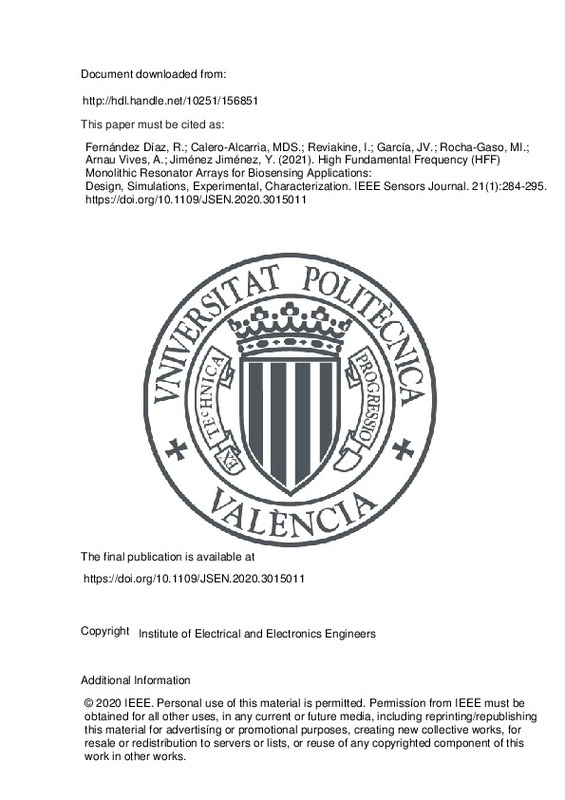JavaScript is disabled for your browser. Some features of this site may not work without it.
Buscar en RiuNet
Listar
Mi cuenta
Estadísticas
Ayuda RiuNet
Admin. UPV
High Fundamental Frequency (HFF) Monolithic Resonator Arrays for Biosensing Applications: Design, Simulations, Experimental, Characterization
Mostrar el registro sencillo del ítem
Ficheros en el ítem
| dc.contributor.author | FERNÁNDEZ DÍAZ, ROMÁN
|
es_ES |
| dc.contributor.author | Calero-Alcarria, María Del Señor
|
es_ES |
| dc.contributor.author | Reviakine, Ilya
|
es_ES |
| dc.contributor.author | García, José Vicente
|
es_ES |
| dc.contributor.author | Rocha-Gaso, María Isabel
|
es_ES |
| dc.contributor.author | Arnau Vives, Antonio
|
es_ES |
| dc.contributor.author | Jiménez Jiménez, Yolanda
|
es_ES |
| dc.date.accessioned | 2020-12-11T04:33:42Z | |
| dc.date.available | 2020-12-11T04:33:42Z | |
| dc.date.issued | 2021-01-01 | es_ES |
| dc.identifier.issn | 1530-437X | es_ES |
| dc.identifier.uri | http://hdl.handle.net/10251/156851 | |
| dc.description | © 2020 IEEE. Personal use of this material is permitted. Permissíon from IEEE must be obtained for all other uses, in any current or future media, including reprinting/republishing this material for advertisíng or promotional purposes, creating new collective works, for resale or redistribution to servers or lists, or reuse of any copyrighted component of this work in other works. | es_ES |
| dc.description.abstract | [EN] Miniaturized, high-throughput, cost-effective sensing devices are needed to advance lab-on-a-chip technologies for healthcare, security, environmental monitoring, food safety, and research applications. Quartz crystal microbalance with dissipation (QCMD) is a promising technology for the design of such sensing devices, but its applications have been limited, until now, by low throughput and significant costs. In this work, we present the design and characterization of 24-element monolithic QCMD arrays for high-throughput and low-volume sensing applications in liquid. Physical properties such as geometry and roughness, and electrical properties such as resonance frequency, quality factor, spurious mode suppression, and interactions between array elements (crosstalk), are investigated in detail. In particular, we show that the scattering parameter, S 21 , commonly measured experimentally to investigate crosstalk, contains contributions from the parasitic grounding effects associated with the acquisition circuitry. Finite element method simulations do not take grounding effects into account explicitly. However, these effects can be effectively modelled with appropriate equivalent circuit models, providing clear physical interpretation of the different contributions. We show that our array design avoids unwanted interactions between elements and discuss in detail aspects of measuring these interactions that are often-overlooked. | es_ES |
| dc.description.sponsorship | The authors would also like to thank Jorge Martínez from the Laboratory of High Frequency Circuits (LCAF) of the Universitat Politècnica de València (UPV) for assistance with profilometry, and Manuel Planes, José Luis Moya, Mercedes Tabernero, Alicia Nuez, and Joaquin Fayos from the Electron Microscopy Services of the UPV for helping with the AFM, and SEM measurements. M. Calero is the recipient of the doctoral fellowship BES-2017-080246 from the Spanish Ministry of Economy, Industry and Competitiveness, Madrid, Spain. | es_ES |
| dc.language | Inglés | es_ES |
| dc.publisher | Institute of Electrical and Electronics Engineers | es_ES |
| dc.relation.ispartof | IEEE Sensors Journal | es_ES |
| dc.rights | Reserva de todos los derechos | es_ES |
| dc.subject | Biosensors | es_ES |
| dc.subject | Crosstalk | es_ES |
| dc.subject | Finite element modeling simulation | es_ES |
| dc.subject | Food safety | es_ES |
| dc.subject | Monolithic arrays | es_ES |
| dc.subject | Nanotechnology | es_ES |
| dc.subject | Pathogen detection | es_ES |
| dc.subject | Piezoelectricity | es_ES |
| dc.subject | Point-of-care | es_ES |
| dc.subject | QCMD | es_ES |
| dc.subject | Quartz crystal microbalance | es_ES |
| dc.subject | Quartz resonators | es_ES |
| dc.subject.classification | TECNOLOGIA ELECTRONICA | es_ES |
| dc.title | High Fundamental Frequency (HFF) Monolithic Resonator Arrays for Biosensing Applications: Design, Simulations, Experimental, Characterization | es_ES |
| dc.type | Artículo | es_ES |
| dc.identifier.doi | 10.1109/JSEN.2020.3015011 | es_ES |
| dc.relation.projectID | info:eu-repo/grantAgreement/MINECO//AGL2016-77702-R/ES/DISEÑO DE UN BIOSENSOR DE ADN BASADO EN TECNOLOGIA HFF-QCM PARA LA DETECCION DE SUSTANCIAS ADULTERANTES EN MIEL/ | es_ES |
| dc.relation.projectID | info:eu-repo/grantAgreement/MINECO//BES-2017-080246/ | es_ES |
| dc.rights.accessRights | Abierto | es_ES |
| dc.contributor.affiliation | Universitat Politècnica de València. Departamento de Ingeniería Electrónica - Departament d'Enginyeria Electrònica | es_ES |
| dc.description.bibliographicCitation | Fernández Díaz, R.; Calero-Alcarria, MDS.; Reviakine, I.; García, JV.; Rocha-Gaso, MI.; Arnau Vives, A.; Jiménez Jiménez, Y. (2021). High Fundamental Frequency (HFF) Monolithic Resonator Arrays for Biosensing Applications: Design, Simulations, Experimental, Characterization. IEEE Sensors Journal. 21(1):284-295. https://doi.org/10.1109/JSEN.2020.3015011 | es_ES |
| dc.description.accrualMethod | S | es_ES |
| dc.relation.publisherversion | https://doi.org/10.1109/JSEN.2020.3015011 | es_ES |
| dc.description.upvformatpinicio | 284 | es_ES |
| dc.description.upvformatpfin | 295 | es_ES |
| dc.type.version | info:eu-repo/semantics/publishedVersion | es_ES |
| dc.description.volume | 21 | es_ES |
| dc.description.issue | 1 | es_ES |
| dc.relation.pasarela | S\417030 | es_ES |
| dc.contributor.funder | Ministerio de Economía y Competitividad | es_ES |







![[Cerrado]](/themes/UPV/images/candado.png)

